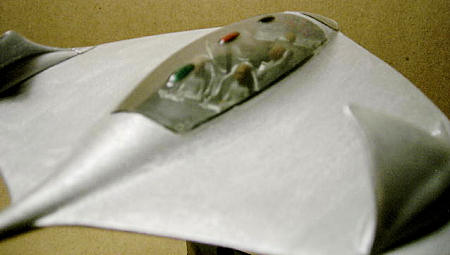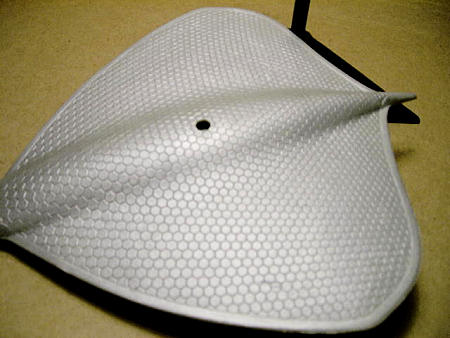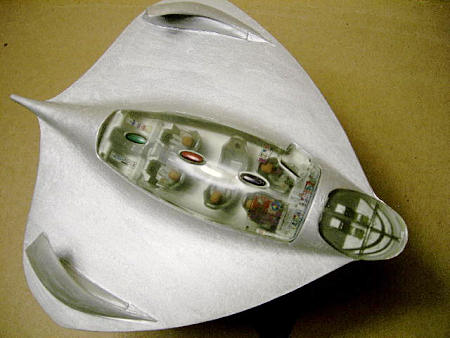
Testors 1/48 Roswell UFO
| KIT #: | 555 |
| PRICE: | $ |
| DECALS: | One option |
| REVIEWER: | Joe Bairn |
| NOTES: | 50th Anniversary Edition |

| HISTORY |
 The
Roswell UFO Incident involves the recovery of materials near Roswell, New
Mexico, USA, on July 8, 1947, and since the late 1970s has become the
subject of intense speculation, rumor, and questioning. There are widely
divergent views on what actually happened and passionate debate about what
evidence can be believed. The United States military maintains that what was
actually recovered was debris from an experimental high-altitude
surveillance balloon belonging to a classified program named "Mogul." Many
UFO proponents maintain that a crashed alien craft and bodies were
recovered, and that the military engaged in a cover-up. The incident has
turned into a widely known pop culture phenomenon, making Roswell synonymous
with UFOs. It ranks as one of the most publicized and controversial UFO
incidents ever. The
Roswell UFO Incident involves the recovery of materials near Roswell, New
Mexico, USA, on July 8, 1947, and since the late 1970s has become the
subject of intense speculation, rumor, and questioning. There are widely
divergent views on what actually happened and passionate debate about what
evidence can be believed. The United States military maintains that what was
actually recovered was debris from an experimental high-altitude
surveillance balloon belonging to a classified program named "Mogul." Many
UFO proponents maintain that a crashed alien craft and bodies were
recovered, and that the military engaged in a cover-up. The incident has
turned into a widely known pop culture phenomenon, making Roswell synonymous
with UFOs. It ranks as one of the most publicized and controversial UFO
incidents ever.History provided by your editor via Wikipedia
The kit is pretty basic with fewer than thirty light gray plastic parts, including the five crew figures and the three piece display stand. Another seven parts I found redundant, but I'm not an engineer..
The front of the instruction sheet
is a reprint of the July 8, 1947 Roswell
Daily Record newspaper. The inside cover
has history of UFO's/ coverup/ referance
books, web sights, and an invite to the UFO
museum in Roswell.
The instructions offer three ways
to build the kit.
Simple: Glue the shell together,
paint, and decal
Intermediate: Finish all the parts
into the spacecraft.
Complete: As above with crew.
 I built the third option. The first step
is the crew compartment cover. This is a
big old window for a 1/48 kit. It's a smoke
colored window, though, and very nice.
There are three clear bubble fairings that
glue into the three ovals along the top of
the canopy. I couldn't feacher how I could
glue clear to clear without it looking
yucky, so I colored the ovals with a felt
tip, one each in red, black and green.
There are four decals that apply to the
forward end. These went on well. I built the third option. The first step
is the crew compartment cover. This is a
big old window for a 1/48 kit. It's a smoke
colored window, though, and very nice.
There are three clear bubble fairings that
glue into the three ovals along the top of
the canopy. I couldn't feacher how I could
glue clear to clear without it looking
yucky, so I colored the ovals with a felt
tip, one each in red, black and green.
There are four decals that apply to the
forward end. These went on well.
The next step are the other four
redundant pieces, the sensor transparances
that mount inside the nose sensor bay. I
put them in there, but a smoke gray clear
flat glued to a gray plastic flat seems a
bit fiddley to me.
The fin halves are glued together,
then to the fuselage top. A technical note
in the instructions says that witnesses
stated the craft had a living sea creature
quality. That being true, the fins need to
be well blended into the fuselage top. I am
completely confident that gap filling can be
accomplished in final painting. Never worked
yet, though. More filler needed here.
The crew was painted so as to show
a nice tan. Their suits are specified as
flat gray, while the interior was to be
metallic silver. I thought silver inside
would be too much, so left both in the
silver gray of the kit plastic, except for
the part listed as the reactor, which I
painted flat black.
The cockpit tub crew compartment
mounts to bosses inside the lower fuselage
half, then the upper half is fit. When this
assembly is cured, the two canopies are
added. These all fit together well, with
the exception of the bottom edge of what
must be the crew hatch to fuselage. Some
white glew, window maker or filler should be
used here.
 I painted the exterior silver, but didn't
note what exactly. From the finish, it was
probably an acrylic aluminum. Another note
says that when found the bottom of the craft
was a light blue. As it cooled, it turned a
dark manganese brown, so I guess any color
between would do. I painted the exterior silver, but didn't
note what exactly. From the finish, it was
probably an acrylic aluminum. Another note
says that when found the bottom of the craft
was a light blue. As it cooled, it turned a
dark manganese brown, so I guess any color
between would do.
The tip of the stick on the
display stand is too long and touches the
bottom of the cockpit tub, making the thing
a "spinner". I cut enough off the end of
the stick to make the thing solid.
This was a pretty easy build with no built in SNAFU's, so it would be a good gift for a young'un just starting to show interest in modeling, space or both. Joe Bairn May 2009 |
If you would like your product reviewed fairly and quickly, please contact me or see other details in the Note to Contributors.